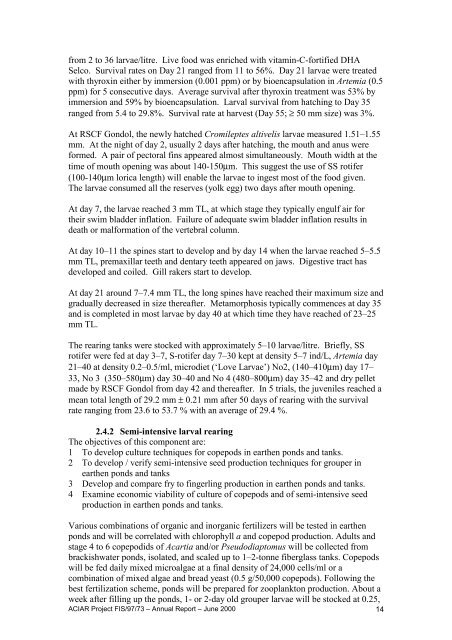ACIAR Project FIS/97/73 - Library - Network of Aquaculture Centres ...
ACIAR Project FIS/97/73 - Library - Network of Aquaculture Centres ...
ACIAR Project FIS/97/73 - Library - Network of Aquaculture Centres ...
You also want an ePaper? Increase the reach of your titles
YUMPU automatically turns print PDFs into web optimized ePapers that Google loves.
from 2 to 36 larvae/litre. Live food was enriched with vitamin-C-fortified DHASelco. Survival rates on Day 21 ranged from 11 to 56%. Day 21 larvae were treatedwith thyroxin either by immersion (0.001 ppm) or by bioencapsulation in Artemia (0.5ppm) for 5 consecutive days. Average survival after thyroxin treatment was 53% byimmersion and 59% by bioencapsulation. Larval survival from hatching to Day 35ranged from 5.4 to 29.8%. Survival rate at harvest (Day 55; ≥ 50 mm size) was 3%.At RSCF Gondol, the newly hatched Cromileptes altivelis larvae measured 1.51–1.55mm. At the night <strong>of</strong> day 2, usually 2 days after hatching, the mouth and anus wereformed. A pair <strong>of</strong> pectoral fins appeared almost simultaneously. Mouth width at thetime <strong>of</strong> mouth opening was about 140-150µm. This suggest the use <strong>of</strong> SS rotifer(100-140µm lorica length) will enable the larvae to ingest most <strong>of</strong> the food given.The larvae consumed all the reserves (yolk egg) two days after mouth opening.At day 7, the larvae reached 3 mm TL, at which stage they typically engulf air fortheir swim bladder inflation. Failure <strong>of</strong> adequate swim bladder inflation results indeath or malformation <strong>of</strong> the vertebral column.At day 10–11 the spines start to develop and by day 14 when the larvae reached 5–5.5mm TL, premaxillar teeth and dentary teeth appeared on jaws. Digestive tract hasdeveloped and coiled. Gill rakers start to develop.At day 21 around 7–7.4 mm TL, the long spines have reached their maximum size andgradually decreased in size thereafter. Metamorphosis typically commences at day 35and is completed in most larvae by day 40 at which time they have reached <strong>of</strong> 23–25mm TL.The rearing tanks were stocked with approximately 5–10 larvae/litre. Briefly, SSrotifer were fed at day 3–7, S-rotifer day 7–30 kept at density 5–7 ind/L, Artemia day21–40 at density 0.2–0.5/ml, microdiet (‘Love Larvae’) No2, (140–410µm) day 17–33, No 3 (350–580µm) day 30–40 and No 4 (480–800µm) day 35–42 and dry pelletmade by RSCF Gondol from day 42 and thereafter. In 5 trials, the juveniles reached amean total length <strong>of</strong> 29.2 mm ± 0.21 mm after 50 days <strong>of</strong> rearing with the survivalrate ranging from 23.6 to 53.7 % with an average <strong>of</strong> 29.4 %.2.4.2 Semi-intensive larval rearingThe objectives <strong>of</strong> this component are:1 To develop culture techniques for copepods in earthen ponds and tanks.2 To develop / verify semi-intensive seed production techniques for grouper inearthen ponds and tanks3 Develop and compare fry to fingerling production in earthen ponds and tanks.4 Examine economic viability <strong>of</strong> culture <strong>of</strong> copepods and <strong>of</strong> semi-intensive seedproduction in earthen ponds and tanks.Various combinations <strong>of</strong> organic and inorganic fertilizers will be tested in earthenponds and will be correlated with chlorophyll a and copepod production. Adults andstage 4 to 6 copepodids <strong>of</strong> Acartia and/or Pseudodiaptomus will be collected frombrackishwater ponds, isolated, and scaled up to 1–2-tonne fiberglass tanks. Copepodswill be fed daily mixed microalgae at a final density <strong>of</strong> 24,000 cells/ml or acombination <strong>of</strong> mixed algae and bread yeast (0.5 g/50,000 copepods). Following thebest fertilization scheme, ponds will be prepared for zooplankton production. About aweek after filling up the ponds, 1- or 2-day old grouper larvae will be stocked at 0.25,<strong>ACIAR</strong> <strong>Project</strong> <strong>FIS</strong>/<strong>97</strong>/<strong>73</strong> – Annual Report – June 2000 14
















